The Story
Bridge is a
heritage-listed steel cantilever
bridge spanning the
Brisbane River that carries vehicular, bicycle and pedestrian traffic between the northern and the southern suburbs of
Brisbane, Queensland, Australia. It is the longest cantilever
bridge in Australia.
The
bridge is part of Bradfield Highway and connects Fortitude Valley to
Kangaroo Point. It is named for prominent public servant,
John Douglas Story.
A
bridge downstream of the Victoria
Bridge was part of a larger plan, devised by Professor Roger Hawken of the University of Queensland in the 1920s, for a series of bridges over the
Brisbane River to alleviate congestion on Victoria
Bridge and to divert traffic away from the
Brisbane central business district. The William Jolly
Bridge was the first of the Hawken Plan bridges to be constructed. Lack of funds precluded the construction of the downstream
bridge at that time. Initially plans called for a transporter
bridge further downstream near New
Farm.
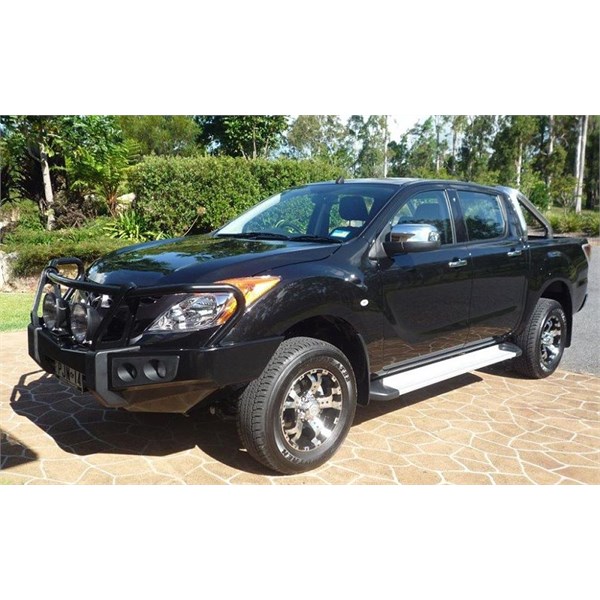
Trish Newman's Mazda
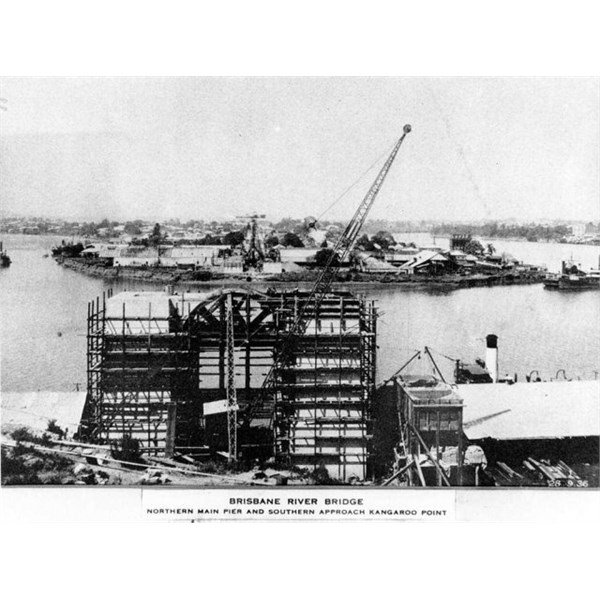
Building the Story Bridge, Brisbane, 1936
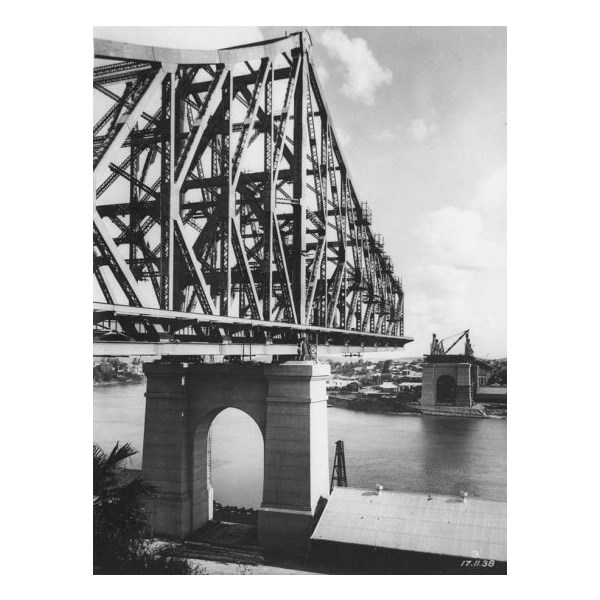
Construction of the Story Bridge, Brisbane, 1938

Brisbane River and Story Bridge, 1939
In 1926
Kangaroo Point was recommended by the
Brisbane City Council's Cross River Commission. Subsequently the
bridge was constructed as a public works program during the Great Depression. The cost was to be no more than £1.6 million.
Before the opening of the
Sydney Harbour Bridge in 1932 the Government of Queensland asked
John Bradfield to design a new
bridge in
Brisbane.
The Queensland Government appointed
John Bradfield on 15 December 1933 as consulting engineer to the Bureau of Industry who were in charge of the construction of the
bridge. In June 1934 Bradfield's recommendation of a steel cantilever
bridge was approved. The design for the
bridge was based heavily on that of the Jacques Cartier
Bridge in Montreal, completed in 1930. On 30 April 1935 a consortium of two Queensland companies, Evans
Deakin and Hornibrook Constructions, won the tender with a bid of £1,150,000.
Construction on the
bridge began on 24 May 1935, with the first sod being turned by the then Premier of Queensland, William Forgan Smith. Components for the
bridge were fabricated in a purpose-built factory at Rocklea. Work sometimes continued 24 hours per day. The
bridge has only one pier on the northern bank but two piers on the lower southern bank, one to bear the weight (the main pier) and, further to the south, one to prevent the
bridge from twisting (the anchor pier).
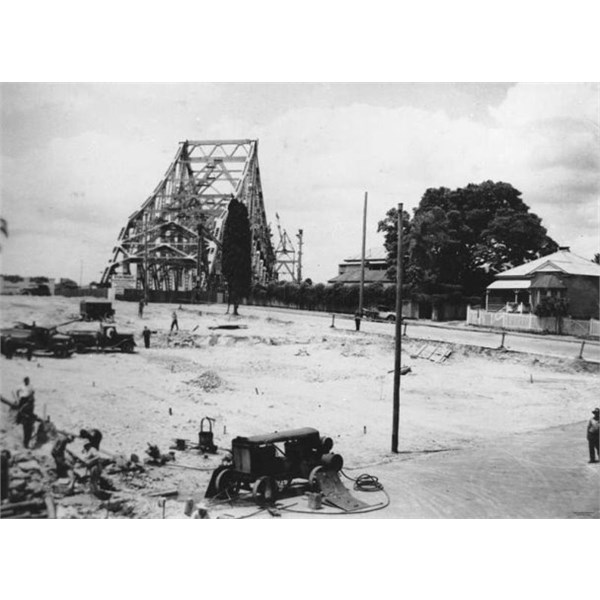
Work underway on the northern approach roadway to the Story Bridge, Brisbane, ca. 1938
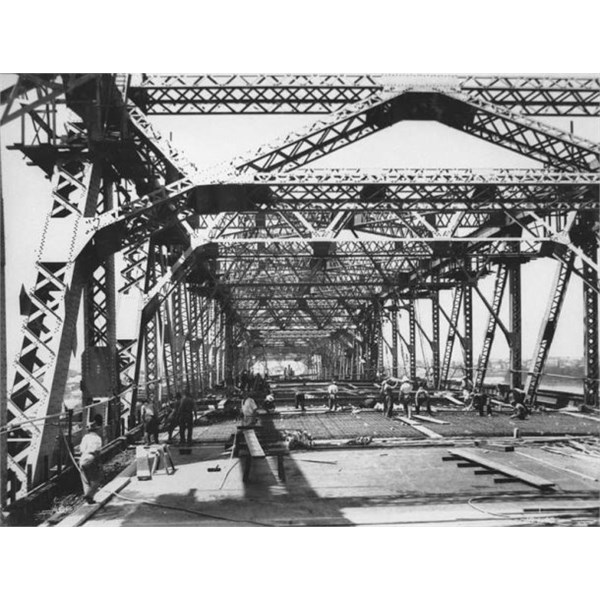
Construction of roadway slab on the Story Bridge, Brisbane, 1940
There was no need for an anchor pier on the northern bank as the
bridge was anchored into schist
cliff face. The major challenge in constructing the
bridge was the southern foundations that went 40 metres below ground level. It was not possible to excavate to that level as water from the level would rapidly seep in. So a pneumatic caisson technique had to be used. As men were working under pressures of up to 4 times normal air pressure, a decompression period of almost 2 hours was needed at the end of each shift to avoid the bends. An on-site air lock hospital successfully treated the 65 cases of the bends that occurred. On 28 October 1939
the gap between the two sides was closed. A concrete decking was then laid, covered by a
Trinidad pitch topping. The
bridge was painted and sodium lighting was installed. The
bridge approaches were also prepared.
Four men died during the construction of the
bridge.
Until it was completed the
bridge was known as the Jubilee
Bridge in honour of King George V. It was opened on 6 July 1940 by Sir Leslie Orme
Wilson, Governor of Queensland and named for
John Douglas Story, a senior and influential public servant who had advocated strongly for the
bridge's construction.
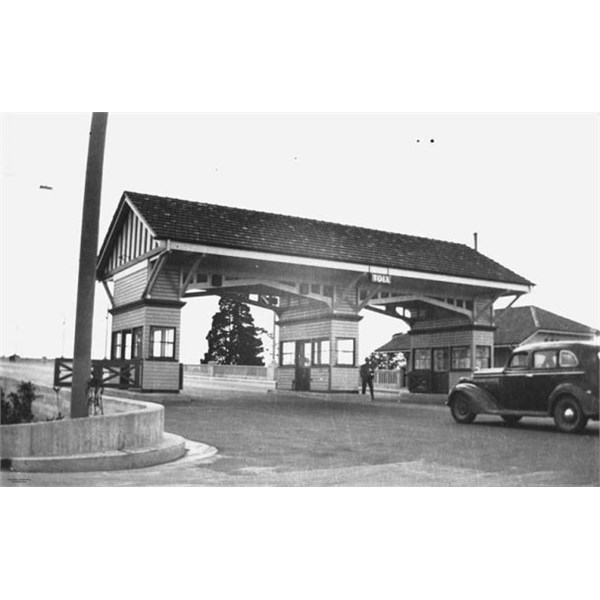
Toll-gate at the Kangaroo Point end of the Story Bridge, Brisbane, 1940
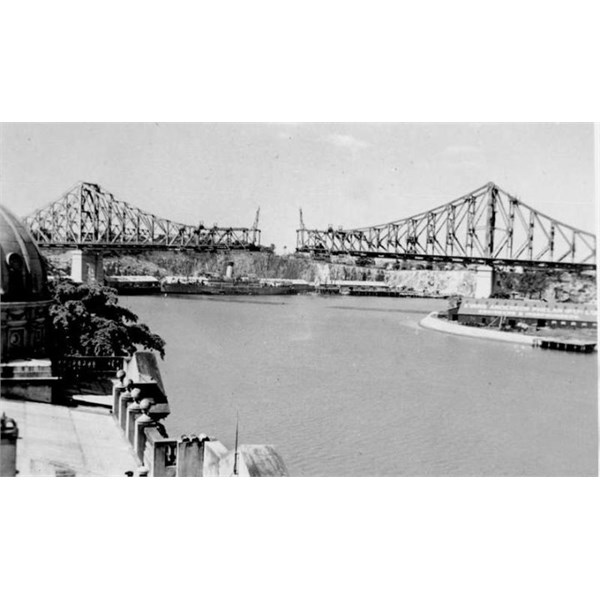
almost completed Story Bridge over the Brisbane River, ca. 1939

Brisbane's Story Bridge under construction, 1939
It took five years to construct and a
river crossing near
Kangaroo Point had first been recommended 14 years before the
bridge was finally completed. One of the major reasons for building the Story
Bridge was actually employment. During the Great Depression, the construction effort provided years of employment for many men as one of the then governments' three public works projects.
The
Bridge is 1,072 metres long from the southern to northern anchor piers.
The river span is 282 metres long.
The
Bridge's summit is 74 metres to ground, similar in height to a 22-story building.
The width of the
Bridge is 24 metres, including footpaths.
The river clearance at low tide is 35 metres, or 10-stories.
39,100 cubic metres were excavated for foundations. 41,250 cubic metres of concrete used
12,000 tonnes of structural steel used, 1,650 tonnes of reinforcing steel used
1,500,000 rivets were used to construct the
bridge.
Currently the
bridge is repainted every 7 years using 17,500 litres of paint
There is approximately 105,000 square metres of painted steel surfaces.
.